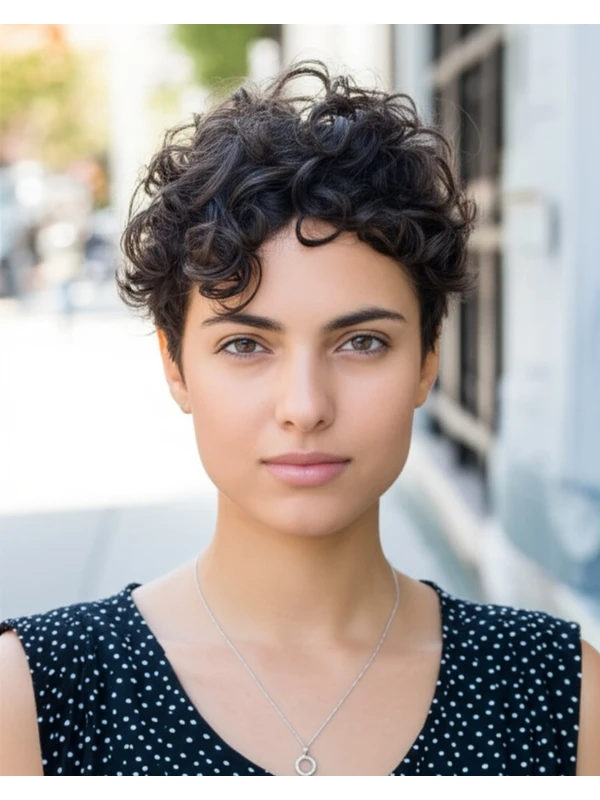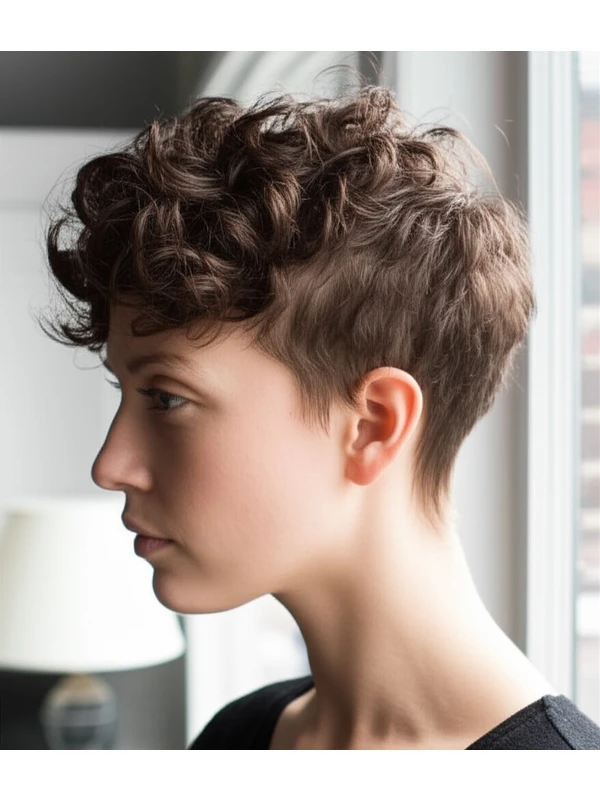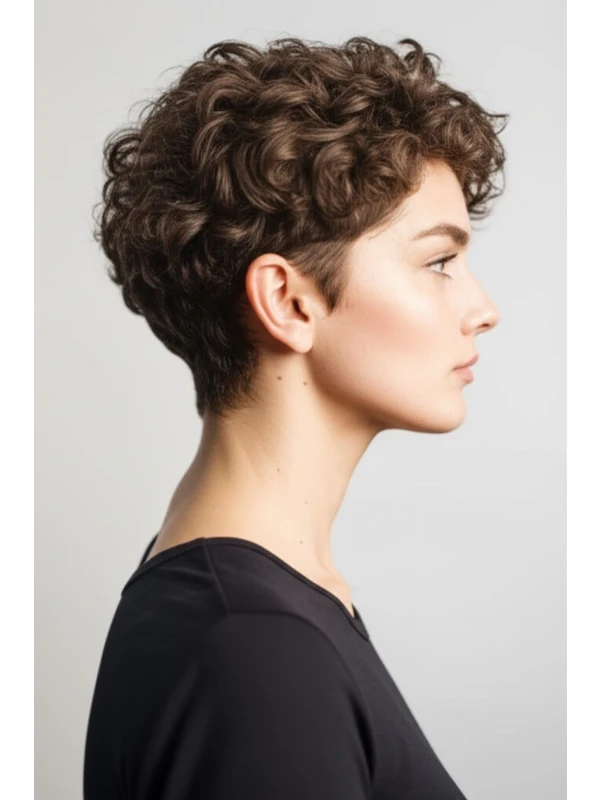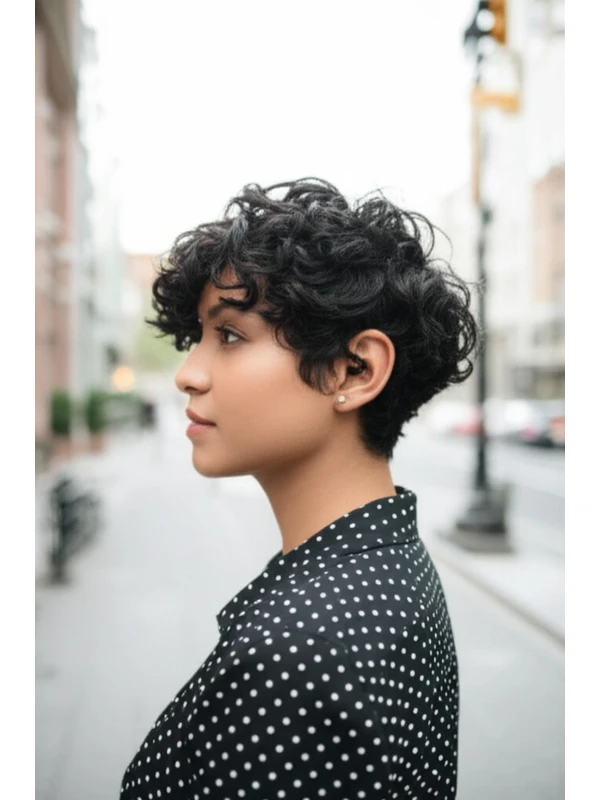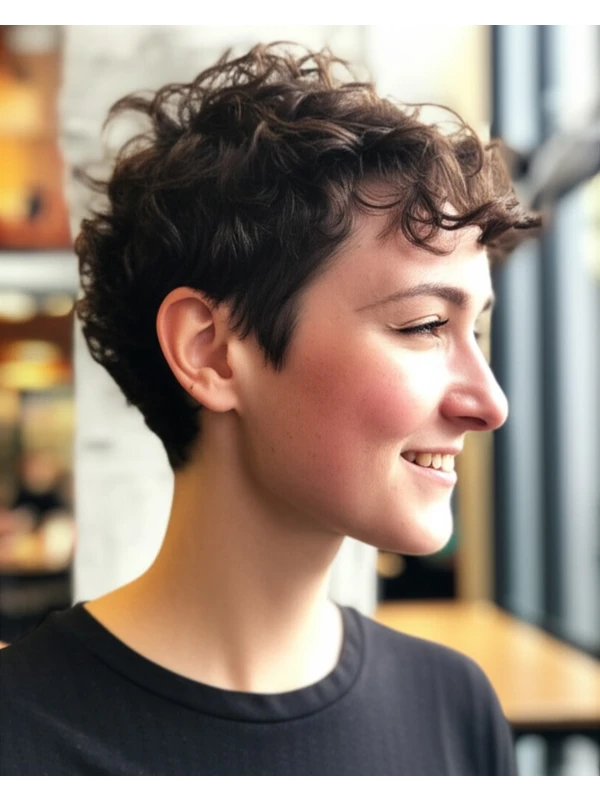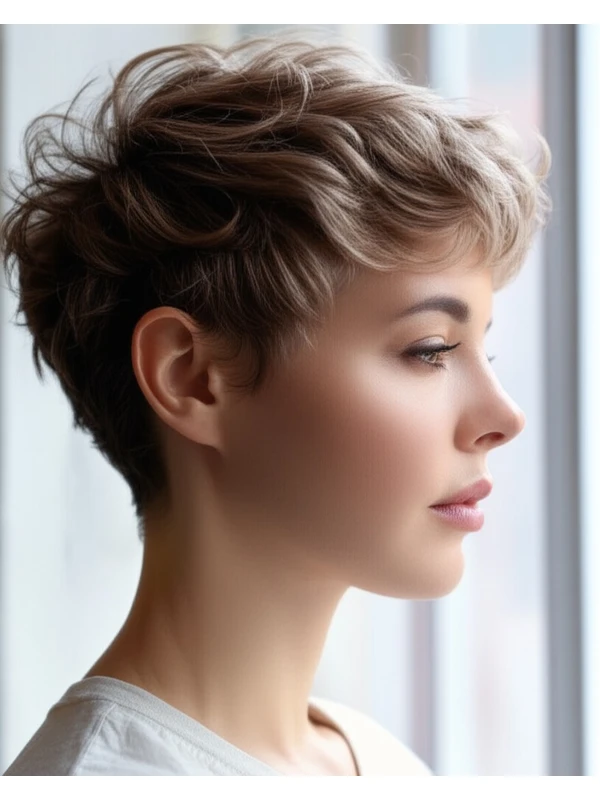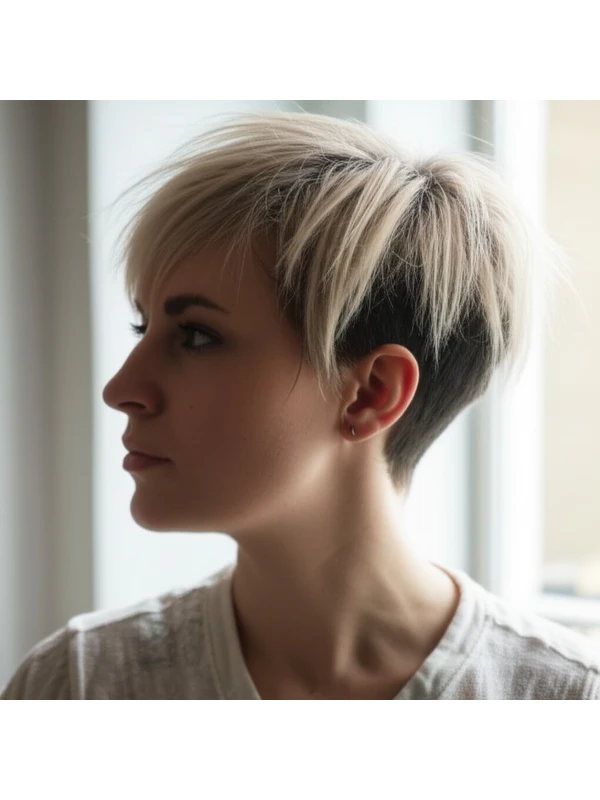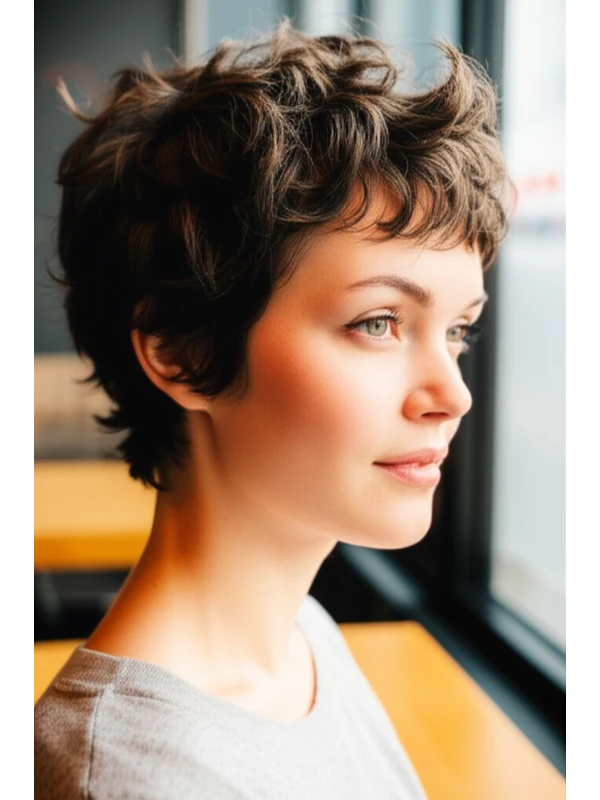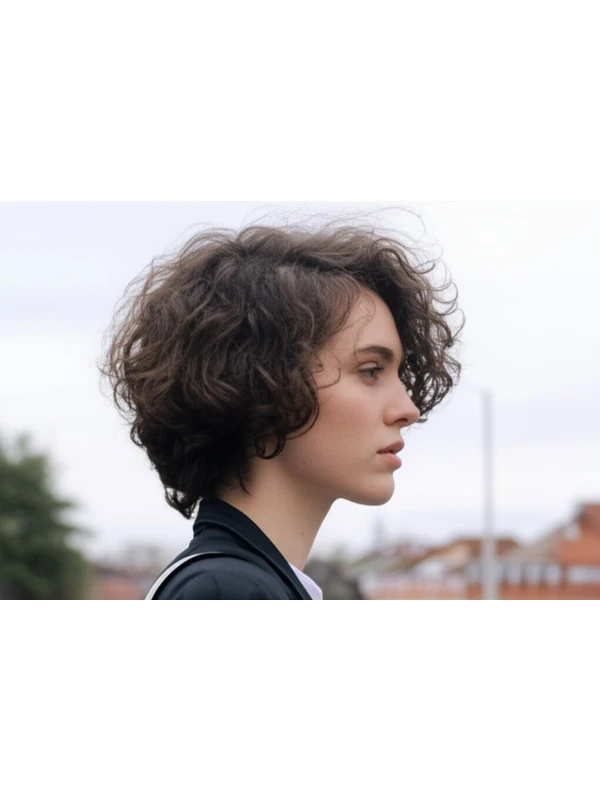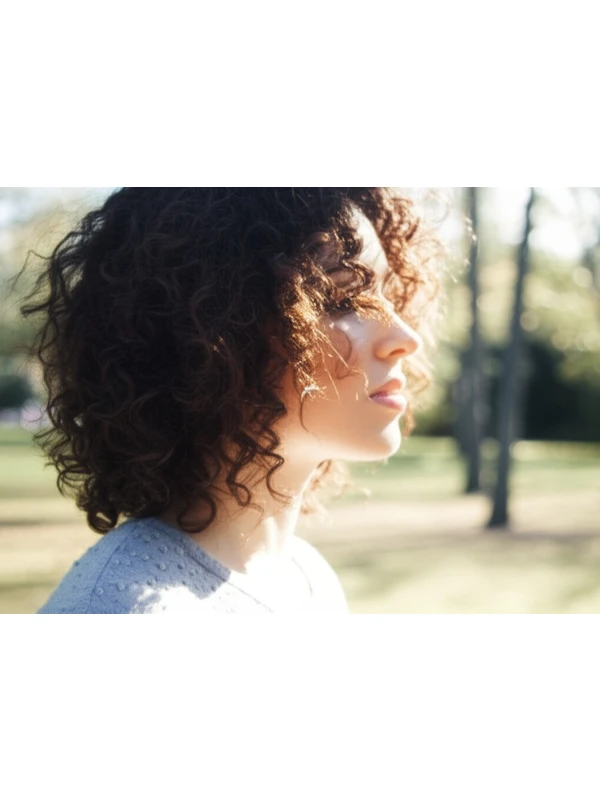#The Curly Pixie: A Bold & Beautiful Transformation
The curly pixie is a playful, chic hairstyle that celebrates natural texture while offering an effortless cool vibe. It’s more than just short hair; it's about embracing volume, shape, and personality. This guide will walk you through everything you need to know before taking the plunge – from finding out if it suits your face shape to mastering everyday styling.
#1) Background & Definition: What is a Curly Pixie?
The curly pixie cut is essentially a short haircut with lots of texture and defined curls or coils. It's characterized by its cropped length, often around 1-3 inches long on top, with shorter sides and back. The key lies in the layering – strategic cuts that allow your natural curl pattern to shine through and create volume.
- Geometry: Think a rounded shape at the crown gradually tapering down towards the neck. The nape of the neck can be short or slightly longer depending on preference.
- Key Features: Volume, texture, defined curls/coils, cropped length, layered for movement.
- Length Ranges: Typically 1-3 inches long on top; sides and back shorter (can range from very close to a few inches).
- Alternative Names: Curly crop, textured pixie with curl, short curly style.
#2) Face Shape Fit: Finding Your Perfect Pixie
The curly pixie can be incredibly flattering for many face shapes – it’s all about adjusting the cut and fringe!
- Oval: Lucky you! Almost any variation of a curly pixie will work beautifully. Play with asymmetry and layering to enhance your features. A side-swept fringe adds softness.
- Round: Height is key! Opt for a version with more volume at the crown, avoiding too much fullness around the cheeks. An angled or asymmetrical fringe can help elongate the face. Avoid blunt bangs that emphasize roundness.
- Square: Soften those angles! A curly pixie with layers and texture will diffuse the sharpness of your jawline. A soft, piecey fringe is a great choice.
- Heart: Balance a wider forehead with a slightly longer fringe or side-swept pieces. Volume on top helps create balance. Avoid too much volume at the chin.
- Diamond: Showcase those cheekbones! A curly pixie that emphasizes width around your eyes and temples will be stunning. A center part can highlight symmetry.
- Oblong (Long): Shorten the appearance of a long face with a more uniform length all over, or create the illusion of width with strategically placed volume on the sides. Avoid styles with excessive height.
#3) Body Proportions & Height Guidance: Tailoring to Your Silhouette
Your body type and height play a role in how a curly pixie looks!
- Petite: A shorter pixie can make you appear even smaller, so opt for more volume at the crown to add visual height.
- Average: Most variations will work well; consider your shoulder width (see below).
- Tall: A slightly longer, more voluminous pixie can help balance a taller frame.
- Narrow Shoulders: Volume on top and around the sides creates the illusion of broader shoulders.
- Broad Shoulders: Avoid excessive volume at the shoulders to prevent them from appearing even wider. A sleeked-back style can be very chic.
- Short Neck: A pixie with more height on top helps elongate the neck visually.
- Long Neck: Shorter sides and a slightly fuller crown can help balance a longer neck.
#4) Works Best With Hair Types & Densities: Understanding Your Texture
The beauty of this cut lies in embracing your natural texture!
- Straight/Wavy: While less common, a curly pixie can work on wavy hair with the right layering and styling techniques to create movement and volume. Texturizing products are essential.
- Curly (2A-3C): This is where the style truly shines! The layers will enhance your curl pattern, creating bounce and definition.
- Coily (4A-4C): A curly pixie can be incredibly flattering for coily hair, showcasing beautiful coils and minimizing shrinkage. Moisture is key to prevent dryness and breakage.
- Fine Hair: Layering is crucial to create the illusion of volume. Avoid overly heavy products that will weigh the hair down.
- Medium Hair: Most variations work well; focus on enhancing your natural texture.
- Thick Hair: Requires more aggressive layering to remove weight and prevent a bulky appearance. Consider thinning shears for optimal shape.
Shrinkage Factor: Curls and coils can shrink significantly when dry! Account for this when determining the length of your pixie – what looks like 3 inches wet might be only 1.5 inches dry.
#5) Styling Variations: From Casual to Chic
The curly pixie is surprisingly versatile!
- Sleek vs Textured: A sleek style uses smoothing products and minimal definition, while a textured style embraces natural curl/coil patterns.
- Middle vs Side Part: A side part adds asymmetry and can soften features.
- Fringe Variations: Blunt bangs (less common), wispy bangs, angled fringe, side-swept fringe – the possibilities are endless!
- Occasion Styling:
- Casual: Air dry with a curl cream or mousse for effortless texture.
- Office: Sleeked back with serum for a polished look.
- Evening: Add hair accessories like clips or headbands, and use a texturizing spray for extra definition.
#6) Maintenance: Keeping Your Pixie Perfect
Regular trims are essential to maintain the shape of your curly pixie!
- Trim Cadence: Every 4-8 weeks (depending on growth rate and desired style).
- At-Home Routine: Gentle cleansing, deep conditioning weekly, leave-in conditioner daily.
- Heat vs Air Dry: Minimize heat styling whenever possible to preserve hair health. When using heat, always use a protectant spray.
- Product Checklist:
- Shampoo & Conditioner (sulfate-free for curls/coils)
- Leave-In Conditioner
- Curl Cream or Mousse (for definition and hold)
- Serum or Oil (to tame frizz and add shine)
- Heat Protectant (if using heat styling tools)
- Estimated Daily Styling Time: 5-15 minutes, depending on desired style.
#7) Grow-Out Roadmap: Evolving Your Look
The curly pixie isn’t a static look! Here's how it changes over time:
- Months 1-3: The initial shape is most defined. Regular trims are crucial to maintain the sharp lines and layers.
- Months 4-6: The style starts to soften as hair grows out. You can experiment with slightly longer layers or a more relaxed fringe.
- Maintaining Shape: Communicate with your stylist about how you want the cut to evolve during grow-out.
#8) Color Pairings: Enhancing Your Pixie
Color can dramatically elevate a curly pixie!
- Cool Undertones (pink, blue): Icy blondes, ash browns, cool reds.
- Warm Undertones (gold, yellow): Honey blondes, copper reds, golden browns.
- Low-Commitment Options: Balayage or highlights add dimension without a drastic all-over color change.
#9) Season & Occasion Guide: Styling for Every Moment
- Spring/Summer: Lighter styling products and more airy textures. Embrace the volume!
- Fall/Winter: Heavier creams and oils to combat dryness. Sleeker styles are also an option.
- Work: Polished, controlled texture – a side part with minimal frizz.
- Weddings: A slightly softer, romantic style with delicate hair accessories.
- Parties: Embrace the playful nature of the pixie! Experiment with bold colors or textured styling.
#10) Cost & Time: What to Expect at the Salon
- Salon Time: Typically 45-90 minutes for initial cut and color (if applicable).
- Price Range: Expect a slightly higher price range than a basic trim, but less expensive than more complex cuts.
#11) Pros & Cons: Weighing Your Options
Pros: Easy to manage, versatile styling options, highlights natural texture, can be very flattering. Cons: Requires regular trims, may not suit all face shapes without adjustments, can feel short initially (a big change!).
#12) Salon Consultation Script: Questions to Ask & Discuss
Here are some prompts to help you communicate your vision with your stylist:
- "I'm interested in a curly pixie cut. Can we discuss what length would be best for my face shape?"
- “Show me examples of curly pixies that suit [your face shape]”
- "How can we incorporate layers to enhance my natural curl pattern/coil definition?”
- “What styling products do you recommend for my hair type and desired look?”
- "Can we discuss how this style will grow out, and what maintenance will be required?"
#FAQs: Your Curly Pixie Questions Answered
- Is a curly pixie difficult to style? Not necessarily! With the right techniques and products, it can be surprisingly easy.
- Will I look too “boyish”? It depends on the cut and styling – volume at the crown and softening around the face can prevent this.
- Can I still wear my hair up with a curly pixie? Limited options compared to longer styles, but you can create fun mini-updos or top knots.
- What if my curls are uneven? A skilled stylist will work with your natural curl pattern and adjust the cut accordingly.
- How do I prevent frizz? Use a leave-in conditioner, avoid harsh sulfates in shampoos, and consider a silk pillowcase.
- Can I dye it myself or is salon color necessary? While touch-ups are possible at home, for significant changes or complex techniques like balayage, professional coloring is recommended.
